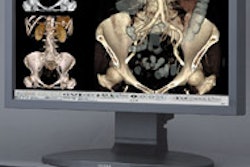The American College of Radiology's task force on international teleradiology has published its report in the February issue of the Journal of the American College of Radiology (JACR), shedding additional light on its position on the practice of overseas interpretations.
The white paper provides an in-depth explanation of why overseas teleradiology guidelines are needed, how the guidelines were arrived at, and a synopsis of the guidelines process, according to a spokesperson for the Reston, VA-based society. The ACR had issued overseas teleradiology guidelines in May 2004.
In general principles, the task force said that international teleradiology (including qualifications of personnel, equipment specifications, licensing, credentialing, and liability) should be performed consistent with the ACR Technical Standard for Teleradiology.
In addition, physicians making an interpretation outside of the U.S. should be appropriately licensed in the transmitting state, have appropriate liability insurance, be appropriately credentialed, and have membership on the transmitting facility's medical staff, according to the task force (Journal of the American College of Radiology, February 2005, Vol. 2:2, pp. 121-125).
Also, the task force said that physicians should independently interpret teleradiology studies that are initially read outside the U.S., and provide the official authenticated written reports.
"Any group that obtains final interpretations from overseas should ensure that such physicians providing image interpretation have proper liability coverage, state licensure, and credentials," the authors wrote.
The task force also said that all physicians providing imaging interpretations, based both in the U.S. and abroad, should regularly participate in the onsite quality assurance process and be involved in documenting that process. These QA programs must be equivalent to or exceed that of the service hospital, according to the task force.
Also, all physicians providing interpretations on emergent cases should be immediately available for consultations; for non-emergent cases, interpreting physicians should either be available for consultations, or make arrangements to communicate their findings, the task force said.
The task force also reminded physicians who employ or contract with radiologists or radiology group practices to interpret imaging studies outside the U.S. that such arrangements are subject to U.S. privacy laws and regulations and applicable state privacy requirements.
"Practices based in the United States that contract for teleradiology services should probably expect to be held jointly responsible for any violations of this act resulting from those services regardless of proximate cause," the task force wrote.
The paper also offered opinions on the appropriateness of various international teleradiology scenarios, including a group lifestyle approach where a contractual employee rotates to a group facility out of the country and provides readings at that remote location only for his group. The remote group member is licensed to practice medicine within the state(s) in which the group provides services, and is credentialed in all of the facilities at which remote readings are rendered.
In another scenario that the task force believes is an acceptable international teleradiology approach, American physicians could provide imaging services from abroad for groups or facilities based in the U.S. other than the group that is their primary employer, linking with groups in their local geographic area to provide interpretive services. The radiologists are licensed in the state(s) and credentialed in all facilities to which services are provided.
Similarly, if the group were to contractually link with groups remote to their local geographical area for interpretive services, the task force believes international teleradiology would be acceptable, with caveats.
"(1) The task force would caution that the medical liability carrier must provide appropriate coverage, and (2) the task force would advocate that individuals making interpretations from outside of the country need to participate in documented ongoing quality assurance programs that meet or exceed that of the service hospital," the task force wrote.
The task force also addressed the issues relating to physicians providing remote imaging services from abroad as employees of a legal entity whose sole purpose is to provide interpretive services to U.S.-based groups or facilities.
In cases where a physician providing services is licensed in the state where the practice of medicine is occurring and is credentialed in the facilities receiving the interpretive services, the task force believes this is an acceptable use of international teleradiology, provided that the radiologist is engaged in appropriate quality assurance and that the practice maintains appropriate liability coverage.
The task force would not find the approach acceptable, however, if a physician did not have both a state license and credentials at the facilities receiving the interpretive services.
By Erik L. Ridley
AuntMinnie.com staff writer
February 15, 2005
Legislation looms over offshore teleradiology services, May 27, 2004
ACR bolsters teleradiology statement, May 14, 2004
Teleradiology providers handle after-hours caseload effectively, May 3, 2004
Overseas teleradiology faces legal hurdles, February 21, 2003
Copyright © 2005 AuntMinnie.com



















